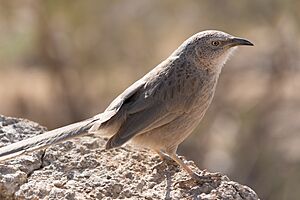Arabian babbler facts for kids
Quick facts for kids Arabian babbler |
|
|---|---|
 |
|
| Conservation status | |
| Scientific classification | |
| Synonyms | |
|
Turdoides squamiceps |
The Arabian babbler (Argya squamiceps) is a special type of passerine bird. These birds live in groups in the dry, scrubby areas of the Middle East. They are known for their strong social bonds and strict pecking order within their groups.
Contents
What is an Arabian Babbler?
The Arabian babbler is a medium-sized bird, about 26 to 29 centimeters (10 to 11 inches) long. Its wings can spread up to 33.5 centimeters (13 inches). It weighs between 64 and 88 grams (2.2 to 3.1 ounces).
This bird has a slightly curved bill and a long tail. Its wings are rounded, and it has strong legs and feet. The feathers are grey-brown on top and lighter underneath. You might see dark streaks on its back. Its throat is usually whitish. Arabian babblers make many different sounds, like whistles, trills, and chattering noises.
Where Do They Live?
Arabian babblers like to live along dry riverbeds. These areas often have a few trees and bushes. You can find them in eastern, southern, and western Arabia. This includes countries like the United Arab Emirates, Oman, Yemen, and western Saudi Arabia. They are not found in the central or northeastern parts of the Arabian Peninsula. Their home range also stretches north to Jordan, Israel, and eastern Sinai. They prefer dry scrubland and savanna areas. In Yemen, they can live up to 2,800 meters (9,200 feet) above sea level.
How Do They Behave?
Arabian babblers are very social birds. They do many things together, like dancing and taking baths. They even offer each other gifts! Sometimes, they clean each other or even feed other babblers in their group. They might also argue over who gets to help another babbler.
This unique behavior has made them famous in the study of animal behavior, called ethology. Scientists are very interested in how babblers show altruism, which means helping others without expecting a reward.
A scientist named Amotz Zahavi studied Arabian babblers for a long time, starting in the 1970s. He developed a theory called the handicap principle. He suggested that when babblers help each other, like feeding chicks, it's a way for them to show off their strength and importance to the group. It's like saying, "Look how strong and capable I am, I can afford to help others!" This helps them gain respect within their group.
Another scientist, Yitzchak Ben-Mocha, has also studied Arabian babblers in Israel. He found that adult babblers use special calls and movements to encourage young birds to move to a new, safe place. This shows they communicate with purpose.
Group Life and Raising Young
Arabian babblers are known as "cooperative breeders." This means they live in groups and work together to raise their young. They defend their home territory all year round. A group can have anywhere from two to ten birds. The size of their territory changes depending on how many birds are in the group and if other babbler groups are nearby.
Each group usually has a main breeding pair (a male and a female who lay eggs). The other birds in the group are "helpers." These helpers might be the offspring of the breeding pair, or they might be other relatives. Helpers usually don't have their own babies. However, they play a big part in raising the young birds. They help by finding food, sitting on the eggs (incubation), defending the territory, and protecting the group from predators.
Groups are often described by who the helpers are:
- Simple group: All the helpers are the children of the breeding pair.
- Complex group: This group has helpers of both sexes who are not directly related to the breeding pair.
Nests and Chicks
Babblers build nests that look like open cups. They usually place these nests in the thickest parts of trees or bushes. Their breeding season typically starts in February and can last until July. When they breed depends a lot on how much rain falls in the area. More rain means more food is available, which is good for raising chicks.
Even though they can mate all year, eggs are usually laid from February to July. Most often, a female babbler lays four eggs, one each day. The eggs are incubated (kept warm) for about 14 days until the chicks hatch. The young babblers are ready to leave the nest about 14 days after they hatch.
What Do They Eat?
Arabian babblers eat a variety of foods. Their diet includes many small creatures without backbones, mostly arthropods like insects. They also eat small animals with backbones, such as lizards, geckos, and even small snakes. Besides animals, they eat plant material like nectar, flowers, berries, leaves, and seeds.
Images for kids



